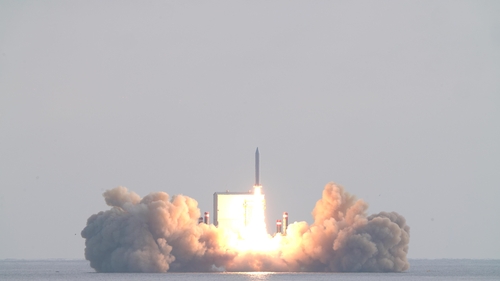- California Assembly OKs highest minimum wage in nation
- S. Korea unveils first graphic cigarette warnings
- US joins with South Korea, Japan in bid to deter North Korea
- LPGA golfer Chun In-gee finally back in action
- S. Korea won’t be top seed in final World Cup qualification round
- US men’s soccer misses 2nd straight Olympics
- US back on track in qualifying with 4-0 win over Guatemala
- High-intensity workout injuries spawn cottage industry
- CDC expands range of Zika mosquitoes into parts of Northeast
- Who knew? ‘The Walking Dead’ is helping families connect
S. Korea successfully conducts third test flight of solid-fuel space rocket
South Korea successfully conducted a third test flight of a solid-fuel space rocket Monday, the defense ministry said, as part of efforts to build its independent space-based surveillance system against North Korea.
The space launch vehicle was launched from a barge floating in waters about 4 kilometers south of Jeju Island at 2 p.m. and placed a small Earth observation satellite into orbit at an altitude of about 650 km, the ministry said.
The 100-kilogram synthetic aperture radar satellite, made by Hanwha Systems, succeeded in sending signals to a ground station at 3:45 p.m., which means it is operating normally, the company said.

The rocket is designed to put a small satellite into a low Earth orbit for surveillance operations. Compared with liquid-fuel space vehicles, solid-fuel ones are known to be usually simpler and more cost-effective to launch.
The space vehicle under development by the state-run Agency for Defense Development uses solid fuel for the first three rockets, while it employs liquid fuel for the fourth stage as it is considered easier to precisely adjust the separation of the payload.
The first two flights in March and December 2022, respectively, tested the performance of three engines except the first-stage booster.
The ministry said it plans to conduct a full-fledged launch when the development is complete to bolster the military’s satellite-based surveillance system, without specifying the schedule.
“Once the development of the solid-fuel space launch vehicle is complete, the South Korean military will be capable of launching small satellites designed for surveillance and reconnaissance in accordance with its security demands and in contingencies,” the ministry said in a release.
In the future, it vowed to develop a space delivery system capable of launching heavier satellites weighing 500-700 kg in low Earth orbit.
The space vehicle’s test flight comes just days after South Korea successfully launched its first spy satellite into orbit on a SpaceX Falcon 9 rocket from Vandenberg Space Force Base in California on Friday.
The launch is part of Seoul’s plan to send five reconnaissance satellites into space by 2025 to better monitor North Korea amid its rising nuclear and missile threats.
On Nov. 21, North Korea placed its first spy satellite into orbit following two failed attempts earlier this year and vowed to launch more in a short span of time.
It also test-fired a Hwasong-18 solid-fuel intercontinental ballistic missile in April and another in July, which are hard to detect due to shorter preparation time compared with liquid-fuel missiles.











